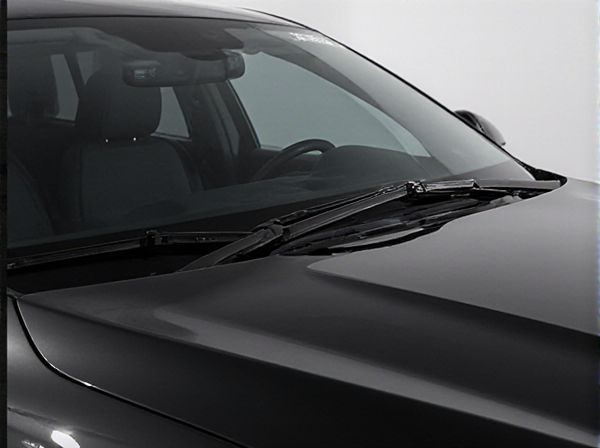
Photo illustration: Rain-Sensing Wiper vs Manual Wiper
Rain-sensing wipers automatically detect moisture on your windshield and adjust their speed accordingly, providing convenience and improved visibility without manual intervention. Manual wipers require you to adjust the speed and activate them yourself, which may be less efficient during sudden rain changes. Choosing rain-sensing wipers enhances safety by allowing you to focus more on driving rather than controlling the wipers.
Table of Comparison
| Feature | Rain-Sensing Wiper | Manual Wiper |
|---|---|---|
| Operation | Automatically detects rain and activates wipers | Requires manual activation and speed adjustment |
| Convenience | Hands-free, adjusts speed based on rain intensity | Driver controls speed and timing |
| Safety | Improves visibility without distraction | Potential distraction due to manual operation |
| Cost | Higher initial cost and maintenance | Lower cost and simpler maintenance |
| Technology | Equipped with rain sensors and control module | Basic mechanical or electrical controls |
| Suitability | Ideal for varied weather and frequent rain | Suitable for occasional, light rain use |
Introduction to Rain-Sensing and Manual Wipers
Rain-sensing wipers automatically detect moisture on the windshield using optical sensors, adjusting the wiper speed and frequency without driver input for enhanced convenience and safety. Manual wipers require the driver to operate the controls to activate and adjust wiper speed based on visibility conditions, offering control but demanding constant attention. Advanced rain-sensing technology improves road visibility during variable weather, while manual wipers provide reliable performance in straightforward applications.
How Rain-Sensing Wipers Work
Rain-sensing wipers use optical sensors mounted on the windshield to detect moisture and automatically adjust the wiper speed and operation based on the intensity of rainfall. These sensors emit infrared light, measuring the amount of light reflected back to determine wetness levels, which triggers the wipers without driver intervention. This technology enhances driving safety by providing optimal visibility and reducing distractions compared to manual wiper control.
Manual Wipers: Basic Operation Explained
Manual wipers operate through direct driver control, requiring physical movement of a lever or switch to activate the windshield wipers. Unlike rain-sensing wipers that automatically adjust speed and frequency based on moisture detected on the windshield, manual wipers provide consistent, fixed-speed wiping determined solely by the driver's input. This system relies on straightforward mechanical or electrical linkages, making it a cost-effective and simple solution for windshield visibility in rainy conditions.
Key Differences Between Rain-Sensing and Manual Wipers
Rain-sensing wipers automatically detect moisture on the windshield using optical sensors and adjust wiper speed accordingly, enhancing driving convenience and safety by maintaining optimal visibility without driver intervention. Manual wipers require the driver to control the wiper speed and activation through a switch or lever, lacking real-time adjustment capabilities and potentially causing delayed response to changing weather conditions. The key difference lies in automation and responsiveness, with rain-sensing wipers providing adaptive performance based on real-time rainfall intensity while manual wipers depend entirely on driver input.
Advantages of Rain-Sensing Wipers
Rain-sensing wipers automatically adjust their speed based on the intensity of rainfall, providing optimal visibility without driver intervention. These wipers enhance safety by reducing distractions and ensuring consistent windshield clarity in varying weather conditions. Their sensors detect moisture levels, enabling quicker response times compared to manual wipers, which require constant driver adjustment.
Benefits of Using Manual Wipers
Manual wipers provide drivers with precise control over wiping speed and frequency, allowing immediate adjustment based on visibility needs without relying on sensors. They eliminate the risk of sensor malfunction or delay, ensuring consistent performance in varying weather conditions. Furthermore, manual wipers tend to be more cost-effective to install and maintain, making them a practical choice for budget-conscious vehicle owners.
Drawbacks of Rain-Sensing Wipers
Rain-sensing wipers can be prone to malfunction in heavy rain or when dirt obstructs the sensor, compromising visibility and driving safety. Their higher cost and complex installation often result in expensive repairs compared to manual wipers. Sensitivity settings might not accommodate all weather conditions, causing inconsistent wiping performance and driver frustration.
Potential Limitations of Manual Wipers
Manual wipers require constant driver attention and adjustment, which can lead to reduced visibility during sudden weather changes or unexpected rain. Unlike rain-sensing wipers that automatically adjust speed and activation based on moisture levels, manual wipers risk delayed response time, increasing the chance of impaired driving safety. Furthermore, inconsistent wiping intervals with manual controls may cause streaks or inadequate clearing, further compromising driver vision.
Cost Comparison: Installation and Maintenance
Rain-sensing wipers typically have a higher initial installation cost due to advanced sensors and integration with vehicle electronics, whereas manual wipers require minimal upfront investment. Maintenance expenses for rain-sensing wipers can be greater because sensor calibration and potential electronic repairs add complexity and costs, while manual wipers mainly incur standard blade replacement fees. Over time, the enhanced convenience of rain-sensing wipers must be weighed against their increased installation and upkeep costs compared to manual wiper systems.
Which Wiper System is Best for You?
Rain-sensing wipers automatically adjust their speed based on the intensity of rainfall, providing convenience and enhanced visibility without driver intervention. Manual wipers offer precise control, allowing drivers to activate or deactivate them as needed, which can be beneficial in varied weather conditions or for those who prefer hands-on operation. Choosing the best wiper system depends on personal preference, driving habits, and environmental factors, with rain-sensing systems ideal for frequent and variable rain conditions, while manual wipers suit drivers who favor simplicity and control.
 caratoz.com
caratoz.com